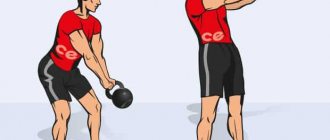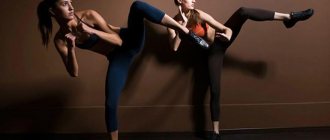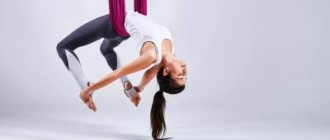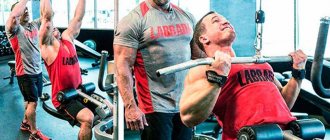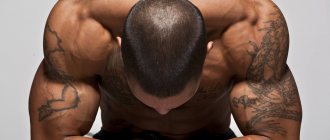Today I want to introduce you to such a wonderful movement as the thruster or barbell throw. This exercise has become widespread in CrossFit and functional training due to its value, but weightlifters were the first to practice it. The exercise is as beneficial as it is challenging, using multiple joints and virtually every muscle in the body. The thruster is great for working your leg muscles, and the force you create as you rise from a squat charges your entire back, torso, and, reaching your shoulders and triceps, throws the barbell into an overhead position. Performing a thruster promotes the development of the respiratory and cardiovascular systems of the body; with the help of this exercise, you can effectively increase the level of overall endurance.
Preparing to run a thruster
When performing thrusters, we need mobility in the hip and shoulder joints. Most athletes performing thrusters for the first time will have problems in the shoulder girdle. How to solve it and protect yourself from injury? First you need to stretch and massage your shoulder muscles well. If you haven’t read the article on warming up before strength training, I highly recommend checking it out.
To self-massage the shoulder muscles in front of the thruster, you will need a Myprotein Recovery ball and a flat wall. We rest our shoulder on the ball and begin to roll it against the wall, self-massaging the anterior and posterior deltoids for at least 30 seconds on each shoulder. Then you need to roll out the hip girdle: using the Pro Muscle Roller massage roller, roll out the gluteal muscle and biceps of the thigh, sitting on the roller and rolling the target muscle along it in different directions. All the muscles that we are paying attention to now are very important not only in thrusters, but in training in general. After rolling and massage, you need to warm up and stretch. It is very important to prepare the shoulder girdle for the thruster: while standing, place an empty barbell on your shoulders, hold it with a grip slightly wider than your shoulders and begin to alternately tuck your elbows forward, trying to take an advantageous frontal position. Then repeat the same, adding 10 kg to the barbell.
Thrusters with weights
When working with kettlebells, you must keep in mind that they are more demanding on the stabilizer muscles (if performed simultaneously with two) than a barbell. Therefore, be careful when determining the weight of the projectile. So that you don’t get “stormy” once again while doing the exercise
Notice how the weights are positioned on your chest. They look in different directions; this position is optimal and allows you to practically not feel tired when holding the projectile.
We rise and throw the weights onto outstretched arms, while simultaneously turning the hand so that the palm faces forward.
We lower ourselves into a squat position and again turn the projectile to its original position on the chest.
I selected the weight of the kettlebell slightly incorrectly, and besides, I filmed the exercise after the complex, so the execution turned out to be a little clumsy. Well, okay, I conveyed the main meaning.
Let's look at the technique
Let's look at the technique of this powerful exercise. It consists of two phases: a front squat with a barbell on the chest and an overhead throw: that is, one repetition of the thruster is one continuous front squat movement followed by an overhead throw. When the barbell lowers back to the chest from the top point, the movement is considered complete and you can begin the second repetition.
- To take the starting position, take the barbell on your chest, place your feet shoulder-width apart or slightly wider. To speed up the execution, you can immediately take the barbell into a squat and begin lifting from the squat followed by a release. If you rack the barbell, you will have to squat down first, and you will spend more time completing the task.
- We perform a deep squat, then, as we rise, we throw the barbell overhead in one continuous movement. The main indicator of squat depth is the requirement to lower the hip joint at the lowest point below the knee. When squatting, support is placed on the entire foot; you cannot switch to the toe. At the lowest point, do not bring your knees inward under any circumstances. The feet and knees should be equally turned to the sides, forming approximately a right angle with each other. Keep your back rigid and don't hunch. Only a slight forward bend is allowed when squatting. For a stronger release of the barbell, when rising from a squat, help yourself by lifting onto your toes.
Technique for performing thrusters with dumbbells
- Take dumbbells in both hands, place your feet slightly wider than your pelvis, with your toes pointed apart.
- Place the dumbbells at your shoulders, holding them with a parallel grip, lower your elbows to the floor.
- As you inhale, squat deeply, lowering your pelvis just below your knees.
- As you exhale, straighten your torso and throw the dumbbells up from the middle of the amplitude.
- At the top point of the movement, the entire body forms a straight line. The dumbbells are positioned clearly above the shoulder joints.
- Lower your arms to shoulder level and at the same time squat while inhaling.
- Repeat the movement.
Grip and elbow position
When performing thrusters, you can hold the barbell with any grip: open or closed. In this case, you do not need to raise your elbows high up; it is important to hold them in such a way as to maintain the pace of the exercise and not overload your shoulders and arms. The most important thing is that the bar does not drag you forward and your back does not hunch.
All work, consisting of two main parts - front squatting and throwing the barbell up - is performed together. This means that immediately after rising from the squat there is no pause, and the barbell is thrown upward using the inertia from rising from the squat. If your physical fitness allows, then when lowering the barbell from the top point, the movement is performed continuously, without a pause on the chest: after lowering to the chest, you immediately go down into a squat. If you do it in a row, without pauses, or as they say in CrossFit, “touch and go,” it is not possible, then you can pause after lowering from the top point to the chest. In this position, you should do one or two cycles of deep breathing and continue with the next repetition. The pace of movement is set by the legs from a squat. After fully straightening from the top point, lower the barbell down. The moment it comes to your shoulders, start squatting.
Exercises
Each complex strength exercise requires attentiveness, concentration and correct execution. To avoid injury and other undesirable consequences, the following rules for the execution of the thruster must be observed.
Barbell Chest Raise
The beam should be in front of the athlete on the shoulders, and the bar should be on top of the back. During squats, keep your back straight so that the bar is over the center of your foot. This way it will hold up when squatting.
Thrusters require athletes to have good flexibility in the wrists, shoulders and hips. Therefore, the CrossFit technique with a barbell on the shoulders is much more difficult than squats with a barbell on the chest, since the back must always be straight, without the slightest bending.
Important! The thruster is designed to train endurance; with such exercises, the quadriceps and deltoid muscles are well pumped, and the heart rate also increases.
Front Squat
The front squat is aimed at training the legs. When performing a front squat, your heels should not come off the floor, so you keep your weight on them. Pull your elbows up and then stand up. It works the hamstrings, quadriceps, glutes, and the front and back of the body.
Did you know? CrossFit competitions have been held since 2007. An interesting thing is that the disciplines in which athletes will compete are announced only a few hours before the start of the games.
Barbell overhead
From a front squat, you should smoothly move into a standing position with the apparatus overhead. In CrossFit, this transition occurs simultaneously. When getting up, you must throw the barbell up until your arms are completely straightened, then fix the bar in this position for a few seconds.
Basic mistakes
The main mistake is holding the barbell using the strength of your arms, in which it does not fall onto your shoulders. In this case, there will be constant tension in your arms, extra work is done and a full release will not occur, since your arms will absorb your explosive force from your legs. When performing a front squat, the barbell should lie on the shoulders only held by the hands; during this phase, the arms should be relaxed. The most common cause of this common mistake is lack of mobility. Let’s say that for those who have already been involved in powerlifting or bodybuilding, but neglected stretching, the arm simply does not fold, the shoulder and wrist are “wooden”.
The next common mistake is performing a squat on the press. Although some competition organizers allow this, in a standard thruster the barbell is thrown in one continuous movement without squatting.
The next mistake is lifting the heel and moving to the toe in a full squat position. This is often accompanied by a hunched back, which is unacceptable.
How to perform a thruster
- Feet shoulder width apart
The barbell lies on the shoulders
Grip the barbell shoulder-width apart (behind them)
Elbows point forward and up
When you start squatting:
- Hips drop down and back
Hips drop below parallel
The back remains straight
Knees are over your toes
As you begin to rise from a squat:
The bar moves along a straight tractor
The joints are fully extended at the top point
Execution Features
Thruster is an extremely energy-intensive exercise, and when performing multi-repetition sets, the pace of movement is important: you must determine your individual pace, which will allow you to breathe deeply and maintain performance for as long as possible.
The muscles of the legs, buttocks and lower back play a key role when performing thrusters. The shoulder girdle serves only a supporting role, so for your thruster to be effective, you need explosive power from your legs. This exercise involves throwing the barbell from a squat position, rather than just a standing press.
Typical execution errors
The most common mistakes CrossFit fans make when doing barbell exercises :
- Elbows and knees are not kept under observation. The technique involves the correct movement of the knees, at an angle proportional to the location of the toes;
- throwing the barbell onto the chest incorrectly;
- take a lot of weight on the barbell. This approach does not keep the back straight and the athlete may be subject to serious injury. In this case, the weight needs to be reduced in order to perform thruster exercises correctly.
Benefits and what muscles work
When performing a thruster, the muscles of the whole body are involved, which is its undoubted benefit. It’s not for nothing that barbell throwing is considered an excellent way to develop strength and endurance.
In fact, this exercise is multi-component, which explains its versatile benefits for the development of not only muscles, but also joints and ligaments.
Related article: “Overhead squats”
If we talk about which muscles and muscle groups are most actively involved, the list will be impressive:
Moreover, the load of the last group depends on the depth of the squat: the lower it is, the more energetically the gluteal muscles will have to work, which means the stronger they will become.
But this is not the whole effect that the thruster gives: it activates metabolism, makes the cardiovascular system work more intensively and promotes ventilation of the lungs.
What is a thruster
Thruster is a complex strength exercise that can use various joints. There are different types of thrusters, including a thruster with kettlebells and dumbbells, but the most popular is the CrossFit with a barbell.
This exercise consists of the following strength elements:
- cleans and squats;
- press press
CrossFit puts a lot of stress on the leg muscles, namely:
- hamstrings;
- quadriceps muscles of the legs;
- gluteal muscles.
Barbell thrusters are incredibly beneficial because they provide multiple strength movements that work the entire body. Despite all its usefulness, CrossFit is not a particularly strenuous exercise. The main thing here is to smoothly repeat the thruster many times with a small weight. Only in this situation will the exercise bring the promised benefits.
Did you know? The exercises in CrossFit are named by the athletes themselves. Light sets of exercises are called by feminine names, and heavy ones by masculine names. Moreover, heavy complexes are named after fallen male heroes (military, firefighters, etc.).
Nuances and errors
Compliance with the rules of execution, using the inertia of the whole body throughout the entire workout is something that needs to be given more attention and time.
It is recommended to perform the thruster while inhaling and exhaling. The squat is done at the entrance, the lunge - at the exhalation. The training is carried out using the inertia of the whole body. Otherwise, breathing will be disrupted and it will be difficult to repeat it.
The exercise should be repeated without stops or pauses, even taking into account the fact that it does not consist of one component. For rest, you are allowed to “hover” a little when the barbell is located above your head or directly at the moment when the barbell has dropped to your chest after the release.
All movements with the barbell must be carried out strictly vertically and in a straight line; violations can lead to injury. It is also strictly forbidden to put your body weight on your toes, because this contributes to the emergence of a forward impulse. This, in turn, compromises lifting power and balance.
When lifting with a barbell, you should rotate your knees so that they point outward. In this way, the gluteal muscles are activated and an impulse is generated that can facilitate the release of the projectile and lighten the load on the arms.
You should raise your elbows, which ensures a fairly stable position for the barbell. This shifts the load, reducing it on the arms and transferring all the force to the legs. So all the main work is done by the muscles of the legs and hips.
It is not recommended to take long pauses between repetitions, because after a long rest, all actions will seem harder and performing the exercise will be much more difficult. Also, do not adhere to too fast a pace. These exercises depend on breathing, and a high tempo can “knock out” the rhythm and breathing may simply not be enough.
It is recommended to perform the thruster while inhaling and exhaling. The squat is done at the entrance, the lunge - at the exhale. The training is carried out using the inertia of the whole body. Otherwise, breathing will be disrupted and it will be difficult to repeat it. Compliance with the rules of execution, using the inertia of the whole body throughout the entire workout is something that needs to be given more attention and time.
Beginning athletes often neglect to follow all the rules for performing exercises. Common errors are:
- Very strong grip. Energy is quickly depleted, making it difficult to repeat exercises several times.
- Poor grip on the bar. To avoid losing your balance, you should hold the equipment tightly when lifting.
- Incorrect breathing. It should be rhythmic: inhale when squatting, exhale when lifting.

